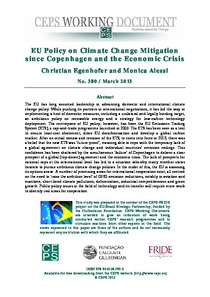EU policy on climate change mitigation since Copenhagen and the economic crisis
"The EU has long assumed leadership in advancing domestic and international climate change policy. While pushing its partners in international negotiations, it has led the way in implementing a host of domestic measures, including a unilateral and legally binding target, an ambitious policy on...
| Main Authors: | , |
|---|---|
| Institution: | ETUI-European Trade Union Institute |
| Format: | TEXT |
| Language: | English |
| Published: |
Brussels
2013
CEPS |
| Subjects: | |
| Online Access: | https://www.labourline.org/KENTIKA-19128171124919463539-eu-policy-on-climate-change-mi.htm |
| Summary: | "The EU has long assumed leadership in advancing domestic and international climate change policy. While pushing its partners in international negotiations, it has led the way in implementing a host of domestic measures, including a unilateral and legally binding target, an ambitious policy on renewable energy and a strategy for low-carbon technology deployment. The centrepiece of EU policy, however, has been the EU Emissions Trading System (ETS), a cap-and-trade programme launched in 2005. The ETS has been seen as a tool to ensure least-cost abatement, drive EU decarbonisation and develop a global carbon market. After an initial review and revision of the ETS, to come into force in 2013, there was a belief that the new ETS was ‘future-proof’, meaning able to cope with the temporary lack of a global agreement on climate change and individual countries’ emission ceilings. This confidence has been shattered by the simultaneous ‘failure’ of Copenhagen to deliver a clear prospect of a global (top-down) agreement and the economic crisis. The lack of prospects for national caps at the international level has led to a situation whereby many member states hesitate to pursue ambitious climate change policies. In the midst of this, the EU is assessing its options anew. A number of promising areas for international cooperation exist, all centred on the need to ‘raise the ambition level’ of GHG emission reductions, notably in aviation and maritime, short-lived climate pollutions, deforestation, industrial competitiveness and green growth. Public policy issues in the field of technology and its transfer will require more work to identify real areas for cooperation." |
|---|---|
| Physical Description: | 15 p. Digital |

